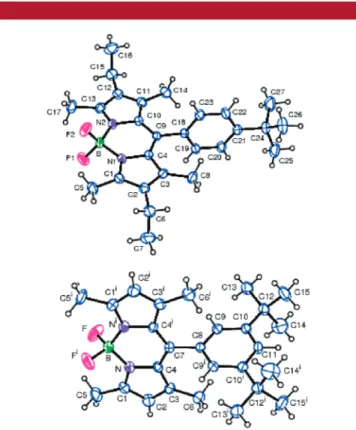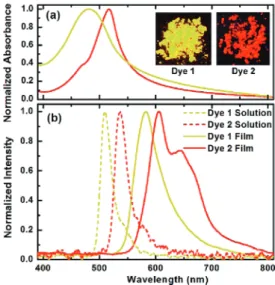Solid-State Emissive BODIPY Dyes with
Bulky Substituents As Spacers
Tugba Ozdemir,†Serdar Atilgan,‡,§Ilker Kutuk,‡Leyla T. Yildirim,|
Abdullah Tulek,†Mehmet Bayindir,†,⊥ and Engin U. Akkaya*,†,#
UNAM-Institute of Materials Science and Nanotechnology, Bilkent UniVersity, 06800 Ankara, Turkey, Department of Chemistry, Middle East Technical UniVersity, 06531 Ankara, Turkey, Department of Chemistry, Suleyman Demirel UniVersity, Isparta 32260, Turkey, Department of Engineering Physics, Hacettepe UniVersity, Beytepe, 06800, Ankara, Turkey, and Departments of Physics and Chemistry, Bilkent UniVersity, 06800 Ankara, Turkey
eua@fen.bilkent.edu.tr Received March 17, 2009
ABSTRACT
Bright fluorescence of the BODIPY dyes, just like most other fluorophores, is quenched in the solid state due to reabsorption and self-quenching. However, introduction of bulky tert-butyl substituents on the meso-phenyl groups result in more spaced packing in the solid state, resulting in highly luminescent powders and films.
Emissive solids are highly in demand for various applica-tions, including photoelectric conversion1and LED (OLED)2 applications. However, organic compounds with emissions in the solid state are rare. This is hardly surprising, because even the brightest emitting fluorophores pack very tightly in the crystalline state or amorphous solid phase (as thin films) leading to very significant quenching.3
In addition, strong extinction of both excitation and emission light in the solid phase, especially if the Stokes’ shift is small,4 should be very detrimental for solid-state
emission. It appeared to us that there may be a relatively easy solution to this problem, even for a fluorophore of high extinction coefficients and small Stokes’ shift such as a typical BODIPY dye, namely, the use of orthogonal bulky substituents. A similar strategy was recently suggested by Zhang and co-workers.5 Very interesting applications of BODIPY dyes emerged in recent years,6 some of them
originating from activity in our group.6e,g
* To whom correspondence should be addressed. Tel: 90 312 290 3570. Fax: 90 312 266 4068.
†UNAM-Institute of Materials Science and Nanotechnology, Bilkent
University.
‡Department of Chemistry, Middle East Technical University. §Department of Chemistry, Suleyman Demirel University. |Department of Engineering Physics, Hacettepe University. ⊥Department of Physics, Bilkent University.
#Department of Chemistry, Bilkent University.
(1) (a) Wang, Z.-S.; Li, F.-Y.; Hang, C.-H.; Wang, L.; Wei, M.; Jin, L.-P.; Li, N.-Q. J. Phys. Chem. B. 2000, 104, 9676. (b) Ehret, A.; Stuhl, L.; Spitler, M. T. J. Phys. Chem. B. 2001, 105, 9960. (c) Hara, K.; Sato, T.; Katoh, R.U¨ .; Furube, A.; Ohga, Y.; Shinpo, A.; Suga, S.; Sayama, K.; Sugihara, H.; Arakawa, H. J. Phys. Chem. B 2003, 107, 597. (d) Thomas, K. R. J.; Kin, J. T.; Hsu, Y.-C.; Ho, K.-C. Chem. Commun. 2005, 4098. (e) Hagberg, D. P.; Edvinsson, T.; Marinado, T.; Boschloo, G.; Hagfeld, A.; Sun, L. Chem. Commun. 2006, 2245. (f) Li, S.-L.; Jiang, J.; Shao, K.-F.; Yang, L.-M. Chem. Commun. 2006, 2792. (g) Zhang, Y.-Q.; Wang, J.-X.; Ji, Z.-Y.; Hu, W.-P.; Jiang, L.; Song, Y.-L.; Zhu, D.-B. J. Mater. Chem. 2007, 17, 90.
ORGANIC
LETTERS
2009
Vol. 11, No. 10
2105-2107
10.1021/ol9005568 CCC: $40.75 2009 American Chemical Society
We now propose that strategic placement of very bulky groups7on the BODIPY core structure should hinder π-π stacking8of the chromophore, which is likely to be respon-sible for the quenching of the emission in the solid state for most aromatic fluorophores; tert-butyl groups are very bulky, and especially when introduced as a 3,5-di-tert-butylphenyl substituent, they are very effective in keeping fluorophore π-systems apart.
With these considerations, we synthesized compounds 1 and 2 (Figure 1). The reactions of appropriate aryl aldehydes and the corresponding pyrroles following usual BODIPY synthesis procedures yielded the dyes 1 and 2 in satisfactory yields. Absorbance and emission spectra in organic solvents were acquired. Both dyes have high quantum yields in organic solvents (ΦF ) 0.83 and 0.91 respectively, in
chloroform).
Suitable crystals for single-crystal X-ray diffraction were obtained by the slow evaporation of CHCl3 solutions at
ambient temperature. Crystal structures were as expected,
with nearly orthogonal (dihedral angles of 79.6° and 84.3° for 1 and 2, respectively) 8-phenyl substituents (Figure 2).
With a careful study of the unit cell, an interesting observa-tion was made: the distance between the closest overlapping near-parallel π-surfaces (defined as the boradiazaindacene framework, planes A in neighboring unit cells in Figures 3 and 4) in compound 1 was considerably larger (14.3 Å) than the similar distance (10.1 Å) in 2. Both of them in turn are much larger compared to a reference BODIPY dye with no meso substituent and available crystallographic structure.9 For that compound (see the Supporting Information), the comparable distance is just 3.51 Å. Between other planes (A-C) the overlap is only partial. This clearly indicates that
(2) (a) Tang, C. W.; VansSlyke, S. A. Appl. Phys. Lett. 1987, 51, 913. (b) Tang, C. W.; VansSlyke, S. A.; Chen, C. H. J. Appl. Phys. 1989, 65, 3610. (c) Schi, J.; Tang, C. W. Appl. Phys. Lett. 1997, 70, 1665. (d) Kraft, A.; Grimsdale, A. C.; Holmes, A. B. Angew. Chem. 1998, 110, 416; Angew. Chem., Int. Ed. 1998, 37, 402. (e) Mitschke, U.; Ba¨uerle, P. J. Mater. Chem.
2000, 10, 1471. (f) Wong, K.-C.; Chien, Y.-Y.; Chen, R.-T.; Wang, C.-F.;
Liu, Y.-T.; Chiang, H.-H.; Hsieh, P.-Y.; Wu, C.-C.; Chou, C. H.; Su, Y. O.; Lee, G.-H.; Peng, S.-M. J. Am. Chem. Soc. 2002, 124, 11576. (g) Tonzola, C. J.; Alam, M. M.; Kaminsky, W. K.; Jenekhe, S. A. J. Am. Chem. Soc.
2003, 125, 13548. (h) Yeh, H.-C.; Chan, L.-H.; Wu, W.-C.; Chen, C.-T. J.
Mater. Chem. 2004, 14, 1293. (i) Chen, C.-T. Chem. Mater. 2004, 16, 4389. (j) Mizobe, Y.; Tohnai, N.; Miyata, M.; Hasegawa, Y. Chem. Commun.
2005, 1839. (k) Berner, D.; Klein, C.; Nazeeruddin, M. D.; de Angelis, F.;
Castellani, M.; Bugnon, P.; Scopelliti, R.; Zuppiroli, L.; Graetzel, M. J. Mater. Chem. 2006, 16, 4468. (l) Ooyama, Y.; Mamura, T.; Yoshida, K. Terahedron Lett. 2007, 48, 5791. (m) Ooyama, Y.; Hayashi, A.; Okamoto, T.; Egawa, H.; Mamura, T.; Yoshida, K. Eur. J. Org. Chem. 2008, 3085.
(3) (a) Ooyama, Y.; Okamoto, T.; Yamaguchi, T.; Suzuki, T.; Hayashi, A.; Yoshida, K. Chem.sEur. J. 2006, 12, 7827. (b) Ooyama, Y.; Kagawa, Y.; Harima, Y. Eur. J. Org. Chem. 2007, 3613.
(4) Langhals, H.; Krotz, O.; Polborn, K.; Mayer, P. Angew. Chem., Int. Ed. 2005, 44, 2427.
(5) Zhang, D.; Wen, Y.; Xiao, Y.; Yu, G.; Liu, Y.; Qian, X. Chem. Commun. 2008, 4777.
(6) (a) Loudet, A.; Burgess, K. Chem. ReV. 2007, 107, 489. (b) Ziessel, R.; Ulrich, G.; Harriman, A. New J. Chem. 2007, 31, 496. (c) Ulrich, G.; Ziessel, R.; Harriman, A. Angew. Chem., Int. Ed. 2008, 47, 1854. (d) Qi, X.; Jun, E. J.; Xu, L.; Kim, S.-J.; Hong, J. S. J.; Yoon, Y. J.; Yoon, J. J. Org. Chem. 2006, 71, 2881. (e) Atilgan, S.; Ekmekci, Z.; Dogan, A. L.; Guc, D.; Akkaya, E. U. Chem. Commun. 2006, 4398. (f) Ela-Erten, S.; Yilmaz, M. D.; Icli, B.; Dede, Y.; Icli, S.; Akkaya, E. U. Org. Lett. 2008, 10, 3299. (g) Ozlem, S.; Akkaya, E. U. J. Am. Chem. Soc. 2009, 131, 48.
(7) (a) Ooyama, Y.; Ishii, A.; Kagawa, Y.; Imae, I.; Harima, Y. New J. Chem. 2007, 31, 2076. (b) Davis, R.; Abraham, S.; Rath, N. P.; Das, S. New J. Chem. 2004, 28, 1368. (c) Horiguchi, E.; Matsumoto, S.; Funabiki, K.; Matsui, M. Bull. Chem. Soc. Jpn. 2005, 78, 1167. (d) Chiang, C.-L.; Wu, M.-F.; Dai, D.-C.; Wen, Y.-S.; Wang, J.-K.; Chen, C.-T. AdV. Funct. Mater. 2005, 15, 231. (e) Ooyama, Y.; Nakamura, T.; Yoshida, K. New J. Chem. 2005, 29, 447. (f) Ooyama, Y.; Yoshikawa, S.; Watanabe, S.; Yoshida, K. Org. Biomol. Chem. 2007, 5, 1260.
(8) (a) de Halleux, V.; Calbert, J.-P.; Brocorens, P.; Cornil, J.; Declercq, J.-P.; Bre´das, J.-L.; Geerts, Y. AdV. Funct. Mater. 2004, 14, 649. (b) Yeh, H.-C.; Wu, W.-C.; Wen, Y.-S.; Dai, D.-C.; Wang, J.-K.; Chen, C.-T. J. Org. Chem. 2004, 69, 6455. (c) Mizukami, S.; Houjou, H.; Sugaya, K.; Koyama, E.; Tokuhisa, H.; Sasaki, T.; Kanesato, M. Chem. Mater. 2005, 17, 50. (d) Yoshida, K.; Yamazaki, J.; Tagashira, Y.; Watanabe, S. Chem. Lett. 1996, 9. (e) Yoshida, K.; Tachikawa, T.; Yamasaki, J.; Watanabe, S.; Tokita, S. Chem. Lett. 1996, 1027. (f) Yoshida, K.; Miyazaki, H.; Miura, Y.; Ooyama, Y.; Watanabe, S. Chem. Lett. 1999, 837. (j) Yoshida, K.; Ooyama, Y.; Tanikawa, S.; Watanabe, S. Chem. Lett. 2000, 714. (k) Yoshida, K.; Ooyama, Y.; Tanikawa, S.; Watanabe, S. J. Chem. Soc., Perkin Trans. 2 2002, 708. (l) Ooyama, Y.; Yoshida, K. New J. Chem. 2005, 29, 1204. (m) Langhals, H.; Potrawa, T.; No¨th, H.; Linti, G. Angew. Chem.
1989, 101, 497.
(9) (a) Bandichhor, R.; Thivierge, C.; Bhuvanesh, N. S. P.; Burgess, K. Acta. Crystallogr., Sect. E 2006, 62, 4310. (b) Wang, D. C.; Wang, H. P.; Gao, S.; Zhang, T. Y.; Peng, X. J. Acta. Crystallogr., Sect. E 2007, 63, 2238.
Figure 1.Structure of compounds 1 and 2.
Figure 2.ORTEP drawings of compounds 1 (top) and 2 (bottom).
introduction of tert-butyl groups act as a molecular separator, extending the lifetime of the excited states in the solid state. Not suprisingly, while both compounds 1 and 2 are lumi-nescent in the solid state, many other BODIPY dyes are not.
Encouraged by the bright luminescence of compounds 1 and 2 in the powder form, thin films of these two dyes were prepared for the determination of emission spectra in the solid state. Dye films were prepared by drop casting the solution with toluene as the solvent, on to the glass substrate, and waiting until the solution dries. Concentrations of the solutions were 10.0 and 36.0 mg/mL for dye 1 and 2, respectively. A subsequent postbaking process was performed under rough vacuum conditions at 80°C for 1 h. The final BODIPY film thickness was 300 nm for dye 1 and 250 nm for dye 2 as determined by the use of a surface texture profiler.
Absorption spectra of the dye films (Figure 5, top) were measured by a spectrophotometer, and the photoluminescence was characterized by exciting at 325 nm using a continuous He-Cd laser and acquiring the emission data by a fiber-coupled spectrometer. The excited area on the films was
approximately 1 mm2, and the average excitation power was
4 mW. The photoluminescence for the solution phase of the dyes was acquired in the same way as the dye films. The introduction of two ethyl substituents on the 2 and 6 positions of the BODIPY core results in a red shift of approximately 30 nm, and this red shift is apparent also in the solid state. Compared to the solution spectra, there is significant red shift of the peak positions in the solid state, which is to be expected, considering stronger intermolecular interactions. Moreover, another smaller peak for compound 2 is clearly present in the spectrum of the dye film obtained using compound 2, which is indicative of the presence aggregate structures in this compound. This is also to be expected, as 3,5-di-tert-butylphenyl groups are clearly superior to 4-tert-butylphenyl groups in keeping the BODIPY units apart.
In conclusion, we demonstrated that simple structural modifications on the BODIPY core can lead to bright emissive compounds in the solid state, and fluorescent thin films can be manufactured without the addition of any polymeric matrix material.
Acknowledgment. We gratefully acknowledge support from the Turkish Academy of Sciences (TUBA) and TUBITAK (Grant Nos. 45 106T348 and 106G090).
Supporting Information Available: Synthesis procedures and additional spectroscopic and crystallographic data. This material is available free of charge via the Internet at http://pubs.acs.org.
OL9005568
Figure 3.Packing diagram for compound 1.
Figure 4.Packing diagram for compound 2.
Figure 5.Absorption spectra of the thin films (top) and the emission spectra (bottom) of the dyes 1 and 2 in solution and as thin films. The inset shows the powder form of the compounds under UV irradiation at 360 nm.

